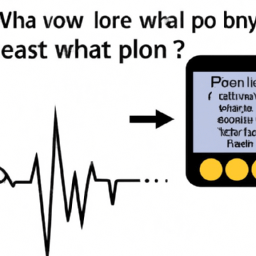What is pulse in BP machine?
The pulse in a BP machine refers to the measurement of the heart rate or the number of times the heart beats per minute. It is usually measured along with the blood pressure and is an important indicator of cardiovascular health. A normal pulse rate for adults is between 60-100 beats per minute. A high or low pulse rate may indicate underlying health conditions that need to be addressed. The pulse can be measured manually by feeling the pulse points or through an electronic device attached to the BP machine.
What is Pulse in BP Machine?
When we talk about blood pressure, we often hear the term "pulse" in relation to the readings obtained from a blood pressure machine. Pulse refers to the rhythmic expansion and contraction of the arteries as blood flows through them. It is measured in beats per minute (BPM) and is an important indicator of overall cardiovascular health.
How is Pulse Measured?
Pulse is typically measured using a pulse oximeter or a blood pressure machine. A pulse oximeter is a small device that clips onto your fingertip and uses light to measure the amount of oxygen in your blood. A blood pressure machine, on the other hand, measures both your blood pressure and your pulse using an inflatable cuff that is wrapped around your arm.
When you use a blood pressure machine, the cuff inflates and deflates to measure the pressure of your blood as it flows through your arteries. The machine also detects the rhythmic pulsations of your arteries and calculates your pulse based on the time between each beat.
Why is Pulse Important?
Pulse is an important indicator of overall cardiovascular health. A healthy pulse rate typically falls between 60 and 100 BPM, although this can vary depending on age, fitness level, and other factors. A consistently high or low pulse rate can be a sign of an underlying health condition, such as heart disease, high blood pressure, or thyroid problems.
Monitoring your pulse regularly can help you to identify any changes or irregularities that may indicate a problem. It can also help you to track your fitness progress and ensure that you are exercising at the appropriate intensity.
How to Take Your Pulse Manually
While blood pressure machines and pulse oximeters are convenient and accurate tools for measuring pulse, it is also possible to take your pulse manually. To do so, follow these steps:
- Find your pulse. You can find your pulse by placing your index and middle fingers on the inside of your wrist, just below the base of your thumb. Alternatively, you can place your fingers on the side of your neck, just below your jawline.
- Count the beats. Once you have located your pulse, count the number of beats you feel in 15 seconds. Multiply this number by four to get your BPM.
It is important to note that taking your pulse manually may not be as accurate as using a blood pressure machine or pulse oximeter. However, it can still provide a general idea of your pulse rate.
Conclusion
Pulse is an important indicator of overall cardiovascular health and can be measured using a pulse oximeter or a blood pressure machine. Monitoring your pulse regularly can help you to identify any changes or irregularities that may indicate a problem. If you are concerned about your pulse rate or have any other health concerns, be sure to speak with your healthcare provider.
| Pros | Cons |
|---|---|
| Easy to use | May not be as accurate as other methods |
| Convenient | May not detect certain irregularities |
| Provides a general idea of pulse rate | |
| By www.zelect.in | |
Sharing is caring!
Facebook Twitter Email
Recommended articles for BP Machine
BP Machine types and buying guide
-
How to Choose the Right Cuff Size for Your BP Machine?
-
Can BP machine be wrong?
-
What is pulse in BP machine?
-
What is sys and dia in BP machine?
-
Which BP machine is accurate
-
Why digital BP machine show different readings?
-
Is manual BP machine accurate?
-
Is wrist BP machine accurate?
-
Is digital BP machine accurate?
-
Does BP machine shows heart rate?
-
BP machine buying guide. Things to know before buy?
-
Are Wrist BP Machines as Accurate as Arm BP Machines?
-
The Difference Between Manual and Digital BP Machines?
-
How to Choose the Best BP Machine for Accurate Readings?
-
Which brand is best for BP machine?
-
Is digital BP machine accurate?
-
Which BP machine is accurate digital or manual?
-
Which BP machine is best for home use digital or manual?
-
What are the types of BP machines and their usage?


